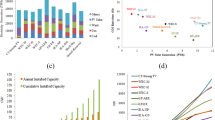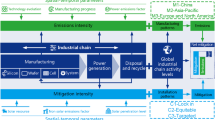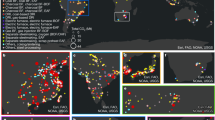Abstract
The broad electrification scenario of recent photovoltaics roadmaps predicts that by 2050 we will need more than 60 TW of photovoltaics installed and must be producing up to 4.5 TW of additional capacity each year if we are to rapidly reduce emissions to ‘net zero’ and limit global warming to <2 °C. Given that at the end of 2020, just over 700 GW peak was installed, this represents an enormous manufacturing task that will create a demand for a variety of minerals. We predict that growth to 60 TW of photovoltaics could require up to 486 Mt of aluminium by 2050. A key concern for this large aluminium demand is its large global warming potential. We show that it will be critical to maximize the use of secondary aluminium and rapidly decarbonize the electricity grid within 10 years if cumulative emissions are to be kept below 1,000 Mt of CO2 equivalent by 2050.
This is a preview of subscription content, access via your institution
Access options
Access Nature and 54 other Nature Portfolio journals
Get Nature+, our best-value online-access subscription
$29.99 / 30 days
cancel any time
Subscribe to this journal
Receive 12 digital issues and online access to articles
$119.00 per year
only $9.92 per issue
Buy this article
- Purchase on Springer Link
- Instant access to full article PDF
Prices may be subject to local taxes which are calculated during checkout





Similar content being viewed by others
Data availability
Data used for the modelling are available in Supplementary Dataset 1.
References
Peters, G. P. et al. The challenge to keep global warming below 2 °C. Nat. Clim. Change 3, 4–6 (2013).
Renewables 2020: Analysis and Forecast to 2025 (IEA, 2020); https://www.iea.org/reports/renewables-2020/solar-pv
Net Zero by 2050: A Roadmap for the Global Energy Sector (IEA, 2021); https://www.iea.org/reports/net-zero-by-2050
International Technology Roadmap for Photovoltaics (ITRPV.net): Results 2020 (ITRPV, 2021).
Electricity Storage and Renewables: Costs and Markets to 2030 (IRENA, 2017); https://www.irena.org/-/media/Files/IRENA/Agency/Publication/2017/Oct/IRENA_Electricity_Storage_Costs_2017.pdf
Future of Solar Photovoltaic: Deployment, Investment, Technology, Grid Integration and Socio-economic Aspects (IRENA, 2019); https://irena.org/-/media/Files/IRENA/Agency/Publication/2019/Nov/IRENA_Future_of_Solar_PV_2019.pdf
Energy Technology Perspectives 2017 (IEA, 2017); https://www.iea.org/reports/energy-technology-perspectives-2017
Creutzig, F. et al. The underestimated potential of solar energy to mitigate climate change. Nat. Energy 2, 17140 (2017).
Victoria, M. et al. Solar photovoltaics is ready to power a sustainable future. Joule 5, 1041–1056 (2021).
Verlinden, P. J. Future challenges for photovoltaic manufacturing at the terawatt level. J. Renew. Sustain. Energy 12, 053505 (2020).
Projected Costs of Generating Electricity 2020 (IEA, 2020); https://www.iea.org/reports/projected-costs-of-generating-electricity-2020
Renewable Capacity Statistics 2021 (IRENA, 2021); https://www.irena.org/publications/2021/March/Renewable-Capacity-Statistics-2021
Hund, K., La Porta, D., Fabregas, T. P., Laing, T. & Drexhage, J. Minerals for Climate Action: The Mineral Intensity of the Clean Energy Transition (World Bank, 2020).
The Role of Critical Minerals in Clean Energy Transitions (IEA, 2021); https://www.iea.org/reports/the-role-of-critical-minerals-in-clean-energy-transitions
Gervais, E., Shammugam, S., Friedrich, L. & Schlegl, T. Raw material needs for the large-scale deployment of photovoltaics – effects of innovation-driven roadmaps on material constraints until 2050. Renew. Sustain. Energy Rev. 137, 110589 (2021).
Zhang, Y., Kim, m, Wang, L., Verlinden, P. & Hallam, B. Design considerations for multi-terawatt scale manufacturing of existing and future photovoltaic technologies: challenges and opportunities related to silver, indium and bismuth consumption. Energy Environ. Sci. https://doi.org/10.1039/D1EE01814K (2021).
Bödeker, J. M., Bauer, M. & Pehnt, M. Aluminium and Renewable Energy Systems—Prospects for the Sustainable Generation of Electricity and Heat (Institut für Energie und Umweltforschung Heidelberg GmbH, 2010); https://www.semanticscholar.org/paper/Aluminium-and-Renewable-Energy-Systems-Prospects-of-Maurice-Bauer/77e625686fe58aca72860a933ff779ff8ec0ba99
Aluminium Sector Greenhouse Gas Pathways to 2050 (International Aluminium Institute, 2021).
Tsakiridis, P. E. Aluminium salt slag characterization and utilization – a review. J. Hazard. Mater. 217–218, 1–10 (2012).
Zhu, Y. & Cooper, D. R. An optimal reverse material supply chain for U.S. aluminum scrap. Proc. CIRP 80, 677–682 (2019).
Li, Y., Yue, Q., He, J., Zhao, F. & Wang, H. When will the arrival of China’s secondary aluminum era? Resour. Policy 65, 101573 (2020).
Kvande, H. The aluminum smelting process. J. Occup. Environ. Med. 56, S2–S4 (2014).
Bertram, M., Martchek, K. J. & Rombach, G. Material flow analysis in the aluminum industry. J. Ind. Ecol. 13, 650–654 (2009).
Brough, D. & Jouhara, H. The aluminium industry: a review on state-of-the-art technologies, environmental impacts and possibilities for waste heat recovery. Int. J. Thermofluids 1–2, 100007 (2020).
Haupin, W. E. Electrochemistry of the Hall-Heroult process for aluminum smelting. J. Chem. Educ. 60, 279 (1983).
Oberbeck, L., Alvino, K., Goraya, B. & Jubault, M. IPVF’s PV technology vision for 2030. Prog. Photovolt. 28, 1207–1214 (2020).
Jordan, D. C., Kurtz, S. R., VanSant, K. & Newmiller, J. Compendium of photovoltaic degradation rates. Prog. Photovolt. 24, 978–989 (2016).
International Aluminium Organisation: Statistics (IAI, 2021).
Mineral Commodity Summaries 2020 (USGS, 2020); https://pubs.usgs.gov/periodicals/mcs2020/mcs2020.pdf
Hao, H., Geng, Y. & Hang, W. GHG emissions from primary aluminum production in China: regional disparity and policy implications. Appl. Energy 166, 264–272 (2016).
Ding, N., Liu, N., Lu, B. & Yang, J. Life cycle greenhouse gas emissions of aluminum based on regional industrial transfer in China. J. Ind. Ecol. https://doi.org/10.1111/jiec.13146 (2021).
Mallapaty, S. How China could be carbon neutral by mid-century. Nature 586, 482–483 (2020).
van Schaik, A. & Reuter, M. A. in Handbook of Recycling (eds Worrell, E. & Reuter, M. A.) 307–378 (Elsevier, 2014).
Bauer, A. J. R. & Laska, C. LIBS for Automated Aluminium Scrap Sorting (TSI Incorporated, 2018).
Jones-Albertus, R., Feldman, D., Fu, R., Horowitz, K. & Woodhouse, M. Technology advances needed for photovoltaics to achieve widespread grid price parity. Progr. Photovolt. 24, 1272–1283 (2016).
Sheppard, Jeff. Carbon nanotube frame improves PV module performance. EE Power (15 April 2015).
Dupuis, J. et al. NICE module technology – from the concept to mass production: a 10 years review. In Proc. 38th IEEE Photovoltaic Specialists Conference 003183–003186 (IEEE, 2012).
Goulden, M., Spence, A., Wardman, J. & Leygue, C. Differentiating ‘the user’ in DSR: developing demand side response in advanced economies. Energy Policy 122, 176–185 (2018).
Moya, J. A. et al. Energy Efficiency and GHG Emissions: Prospective Scenarios for the Aluminium Industry JRC Scientific and Policy Reports (European Commission, 2015).
Butler, C., Maxwell, R., Graham, P. & Hayward, J. Australian Industry Energy Transitions Initiative Phase 1 Technical Report Report No. 978-0-9871341-9-6 (ClimateWorks Australia, 2021).
Kraemer, Susan. Australian researchers assess the commercial viability of solar alumina calcining. SolarPACES (3 August 2020).
Padamata, S. K., Yasinskiy, A. S. & Polyakov, P. V. Progress of inert anodes in aluminium industry: review. J. Sib. Fed. Univ. Chem. 11, 18–30 (2018).
Aluminium (IEA, 2020); https://www.iea.org/reports/aluminium
Yasinskiy, A. S., Padamata, S. K., Polyakov, P. V. & Shabanov, A. V. An update on inert anodes for aluminium electrolysis. Light Met. Carbon Mater. 1, 15–23 (2020).
Haller, M. Y., Carbonell, D., Dudita, M., Zenhäusern, D. & Häberle, A. Seasonal energy storage in aluminium for 100 percent solar heat and electricity supply. Energy Convers. Manag. 5, 100017 (2020).
Life Cycle Inventories and Life Cycle Assessments of Photovoltaic Systems 2020 (IEA, 2020).
Fthenakis, V. M. & Kim, H. C. Life cycle assessment of high-concentration photovoltaic systems. Progr. Photovolt. 21, 379–388 (2013).
Solar PV Trade and Manufacturing: A Deep Dive (Bloomberg NEF, 2021).
Acknowledgements
This work has been supported by the Australian Research Council (ARC) through the Future Fellowship FT170100447 (awarded to A.L.) and the Australian Renewable Energy Agency (ARENA) research grant number 2017/RND002. We also acknowledge funding support from the Australian Centre of Advanced Photovoltaics (ACAP), which is funded by ARENA. J. Buchan (UNSW, Sydney, Australia) and C. Preston (University of Sydney, Sydney, Australia) are thanked for proof reading the manuscript.
Author information
Authors and Affiliations
Contributions
A.L. conceived the study, conducted the modelling and was the primary author of the manuscript. M.L. and P.R.D. contributed to the discussion of sustainability and recycling and B.H. to the discussion on projected PV technology trends. All authors contributed to the manuscript structure and proof reading.
Corresponding author
Ethics declarations
Competing interests
The authors declare no competing interests.
Peer review
Peer review information
Nature Sustainability thanks Timothy Laing, Atse Louwen and the other, anonymous, reviewer(s) for their contribution to the peer review of this work.
Additional information
Publisher’s note Springer Nature remains neutral with regard to jurisdictional claims in published maps and institutional affiliations.
Supplementary information
Supplementary Information
Supplementary Figs. 1–6 and Tables 1–6.
Supplementary Dataset 1
Excel file with modelling data.
Rights and permissions
About this article
Cite this article
Lennon, A., Lunardi, M., Hallam, B. et al. The aluminium demand risk of terawatt photovoltaics for net zero emissions by 2050. Nat Sustain 5, 357–363 (2022). https://doi.org/10.1038/s41893-021-00838-9
Received:
Accepted:
Published:
Issue Date:
DOI: https://doi.org/10.1038/s41893-021-00838-9
This article is cited by
-
Solar power challenges
Nature Sustainability (2022)
-
Solar power’s need for a carbon-intensive metal is set to soar
Nature (2022)



